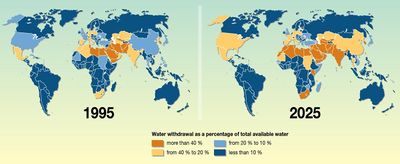Desalination - Team B
Reverse Osmosis Desalination Plant in Durban, South Africa
Authors: Lauren Burke, Cindy Chen, Osman Jamil, Natalia Majewska
Instructors: Fengqi You, David Wegerer
March 11, 2016
Executive Summary
An imminent global shortage of water will greatly affect the lives of millions of people. The situation in South Africa is predicted to exacerbate in the upcoming decades. This growing need for fresh drinking water motivated the design of a reverse osmosis desalination plant in the suburbs of Durban on the eastern coast of South Africa. A reverse osmosis process was selected based on the water salinity in the area and recent technological advancements in membrane efficiency.
The process is designed to operate for 350 days a year, 24 hours a day to yield 132,000 m3 of water per day. Prior to reverse osmosis, the seawater is pretreated to prevent membrane fouling using a cascade of filters and high-pressure pumps. Reverse osmosis is carried out at 37 bar with two banks containing 900 and 4000 membranes, respectively. After reverse osmosis, the pressurized concentrate that contains the unwanted salts and ions is sent to an energy recovery device to pressurize the reverse osmosis feed. The deionized water from the reverse osmosis system is remineralized and disinfected before being sent to the consumer.
Based on a thorough economic analysis, it has been determined that the process is not feasible at this stage. The annual estimated revenue is $37.5 MM. In addition, the 20 year NPV of the plant is -$23.5 MM with an IRR of 2.9%. A sensitivity analysis indicated that an increase in the price of water could potentially increase profits. Therefore, the design may become profitable implemented with the aid of government subsidies or if a drastic increase in water scarcity increases the selling price of water.
Introduction
Background
Close to 1.2 billion people, approximately one fifth of the world’s population, reside in areas of physical water scarcity [1]. Although there is enough water in the world for a population of seven billion people, it is unevenly distributed, and many regions have been experiencing water shortages for more than a decade. Given the current rate of population growth and water consumption, many studies predict that this problem will be exacerbated in the years to come. Water desalination is a process used to purify water so that it meets drinking standards for consumption. The two main technologies used for desalination are thermal desalination and reverse osmosis. While thermal desalination is a robust method that scales well, it is typically preferable for inlets of very high salt concentrations and very low energy costs, such as the gulf coast region. Reverse osmosis plants are more prevalent elsewhere, making up 80% of all desalination plants in the world [2]. Given the salinity of the inlet flow for this process and advances in technology, reverse osmosis has been selected as the optimal choice for this project.
Location Selection
The Durban area in South Africa has been selected as the location of this project since it is currently experiencing approximately 25% water withdrawal as a percentage of total available water. This value is projected to increase in the upcoming years to 40% water withdrawal due to physical water scarcity [3,4] as can been seen in Figure 1.
In addition to the increasing water scarcity in the next decade, this location was selected due to relatively low location costs and salinity levels as seen in Appendix A. South Africa has a location cost factor of 1.1, which is only 10 % more than the Gulf Coast basis. The country also has relatively low cost of labor and has a labor productivity factor of 1.3 [5]. To provide energy for this process, hydroelectric power from a plant located approximately 200 km away from the proposed location will be used, allowing for a more sustainable energy source at a stable price point. Five desalination plants already exist in the country; all located on the western coast, in suburban areas as shown in Appendix B. A plant located on the eastern side, specifically in Amanzimtoti, near the large metropolis of Durban, would supplement these existing facilities by increasing the amount of available drinking water and provide an economic boost to an area that has one of the largest percentages of agricultural households in the country.
Preliminary Market Analysis and Process Selection
Process Feed and Composition
Process Alternatives
Pretreatment
Membrane Selection
Energy Recovery
Remineralization
Disinfection
Waste Treatment
Process Overview
Process Flow Diagram
Mass and Energy Balances
Equipment Sizing and Trade-offs
Economic Analysis
Sensitivity Analysis and Optimization
Conclusion
References
Appendices
Appendix A
etc.
